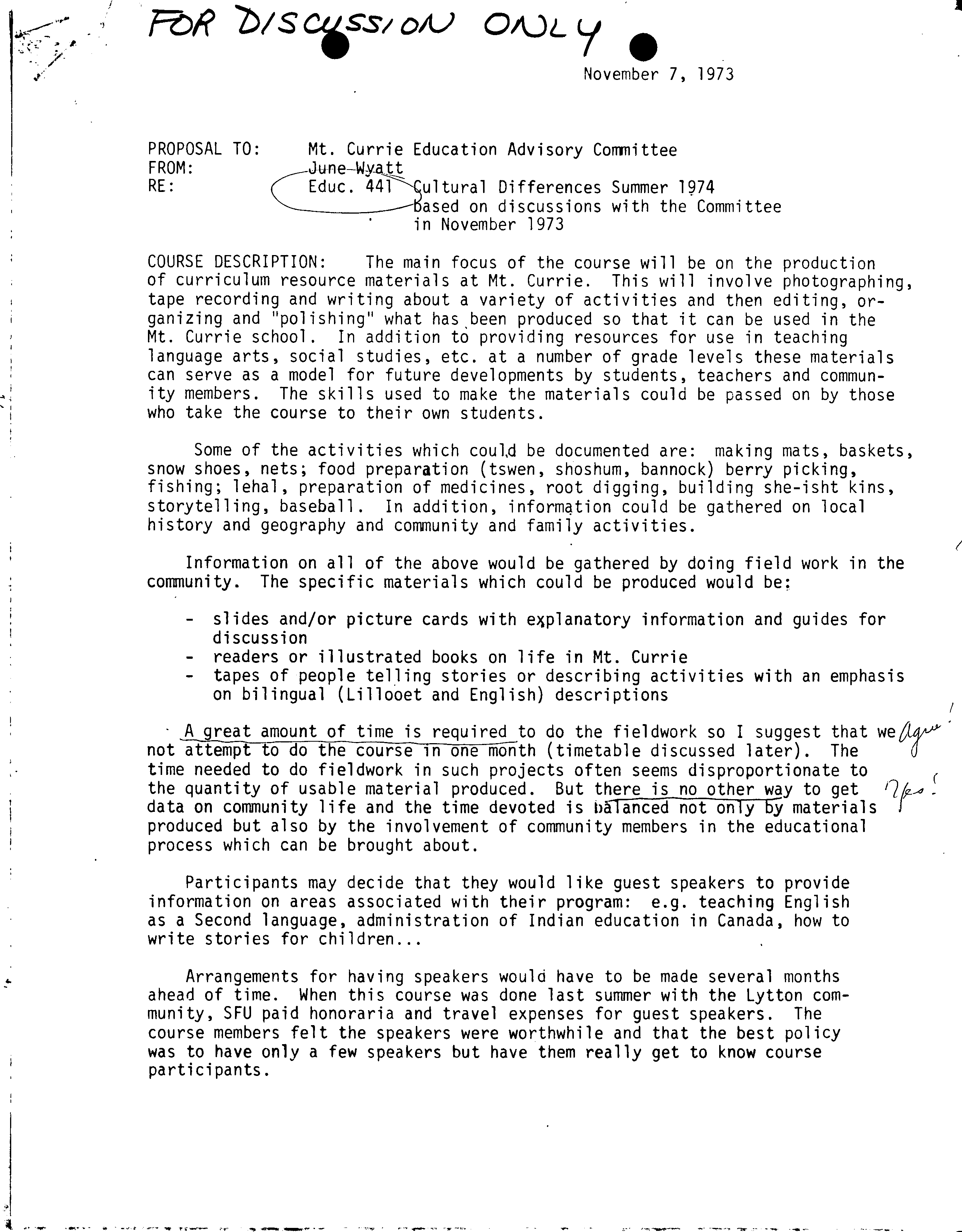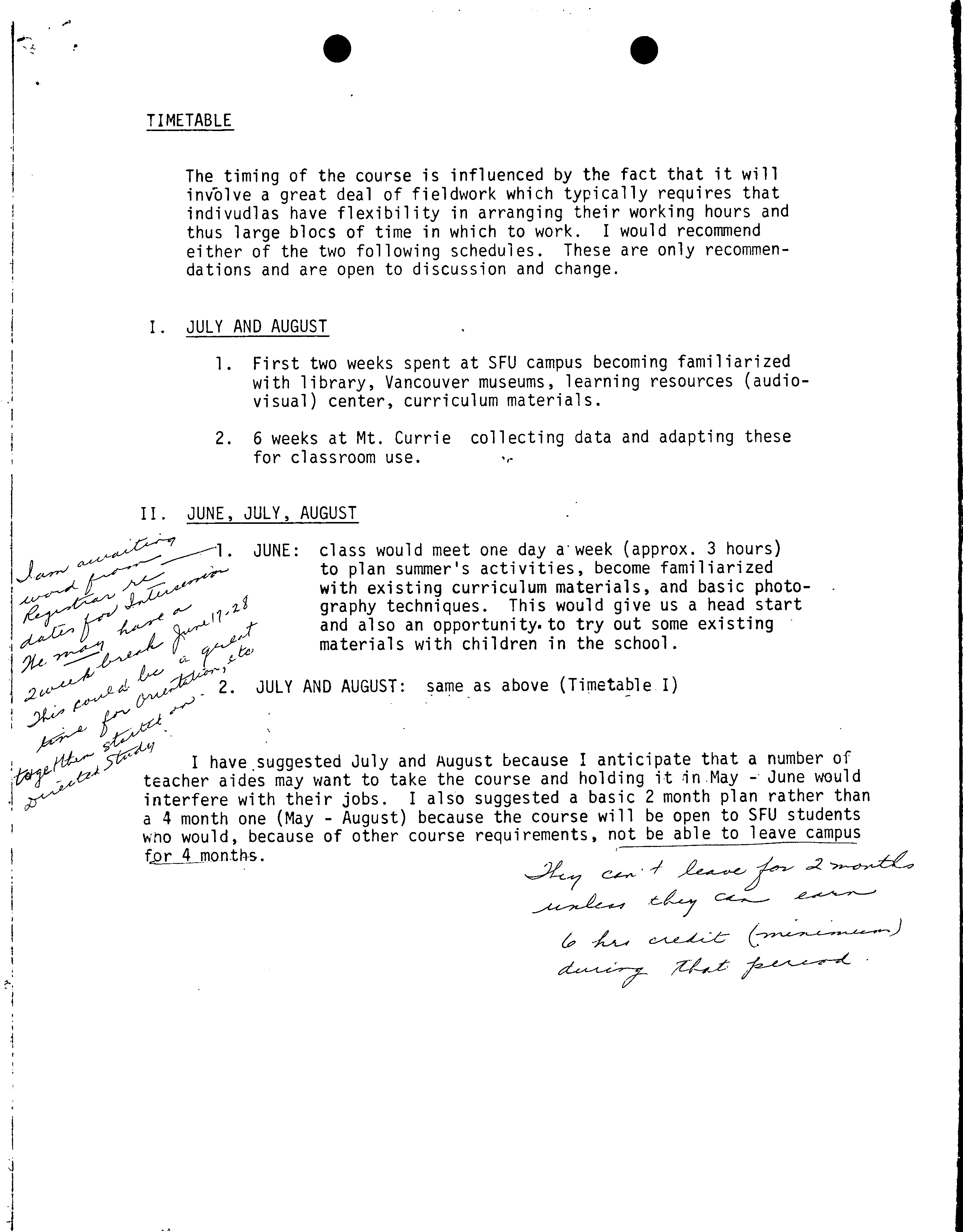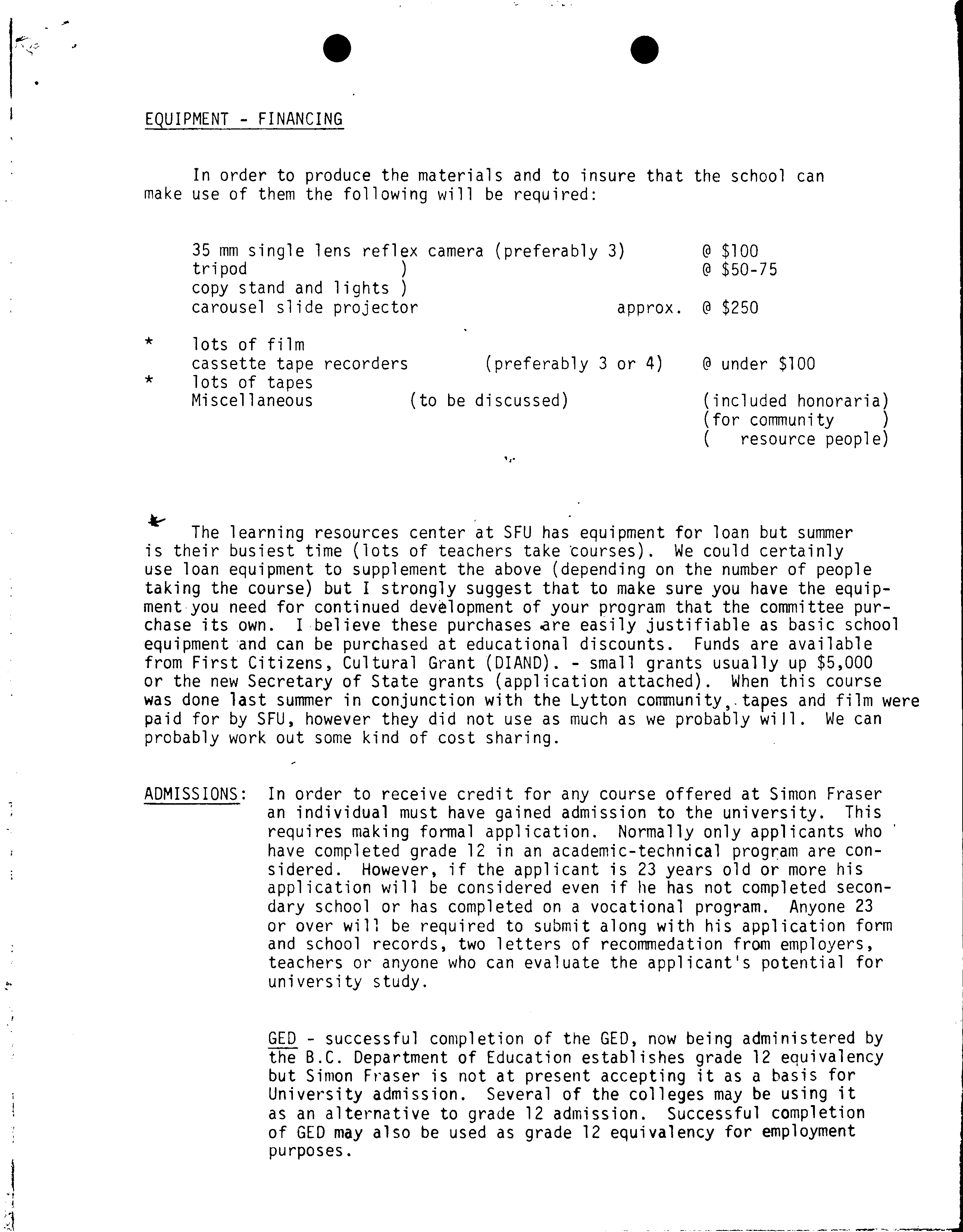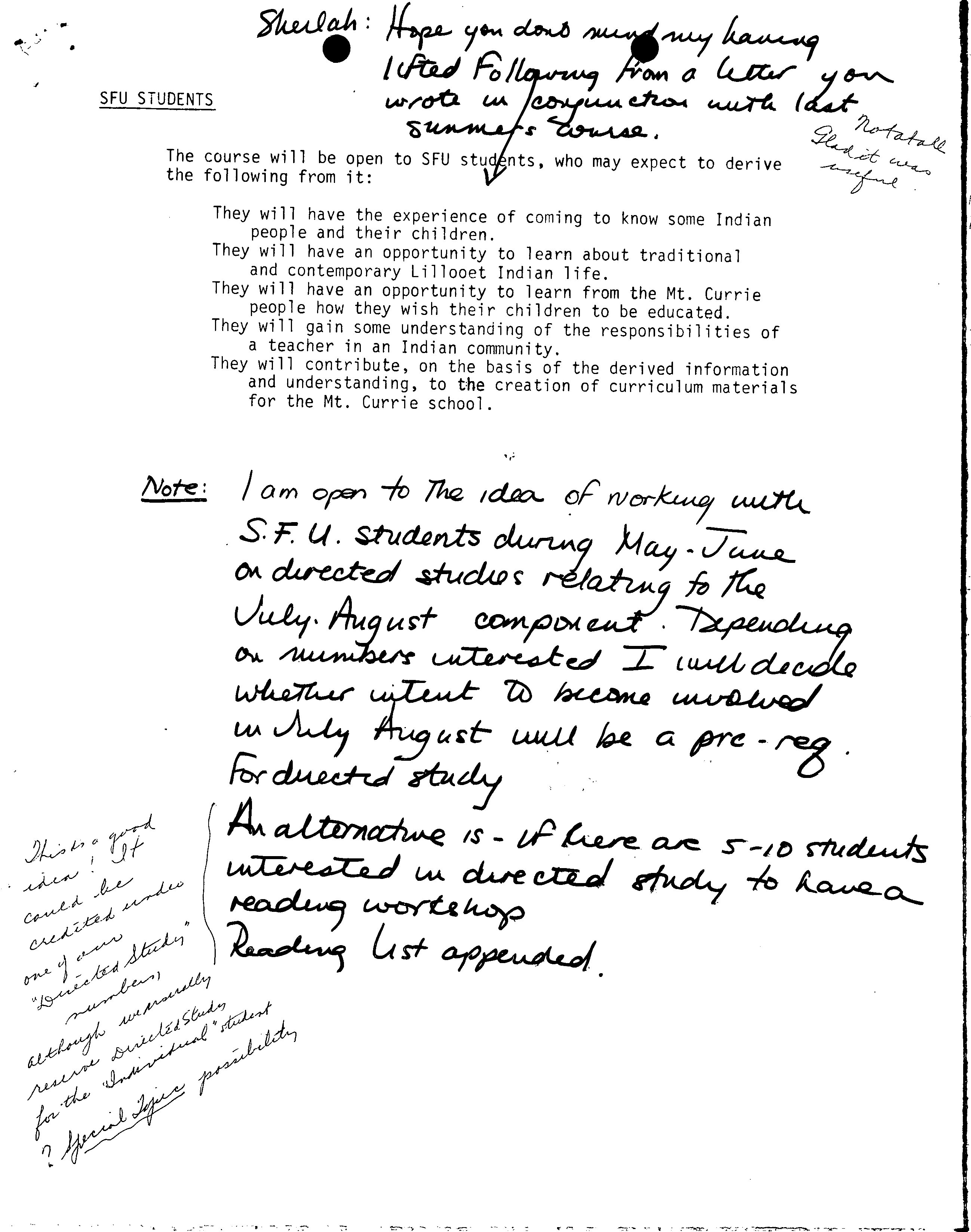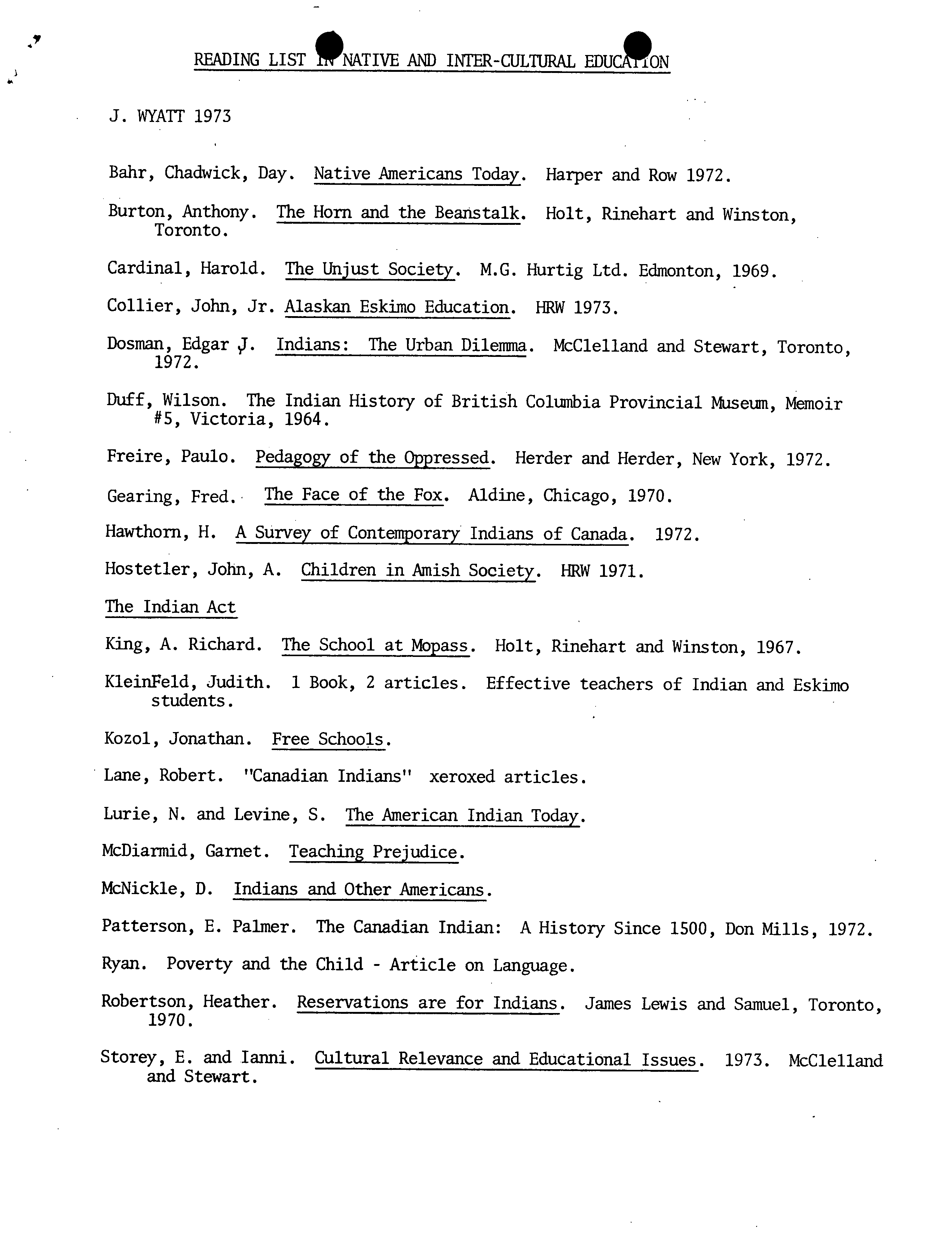7.
I
FOR
/ S
?
o,L)
Q/ULL, .
November 7, 1973
PROPOSAL TO: ?
Mt. Currie Education Advisory Committee
FROM: ?
June—Wyatt
RE: ?
ultural Differences Summer 1974
ased on discussions with the Committee
in November 1973
COURSE DESCRIPTION: ?
The main focus of the course will be on the production
of curriculum resource materials at Mt. Currie. This will involve photographing,
tape recording and writing about a variety of activities and then editing, or-
ganizing and "polishing' what has been produced so that it can be used in the
Mt. Currie school. In addition to providing resources for use in teaching
language arts, social studies, etc. at a number of grade levels these materials
can serve as a model for future developments by students, teachers and commun-
ity members. The skills used to make the materials could be passed on by those
who take the course to their own students.
Some of the activities which could be documented are: making mats, baskets,
snow shoes, nets; food preparation (tswen, shoshum, bannock) berry picking,
fishing; lehal, preparation of medicines, root digging, building she-isht kins,
storytelling, baseball. In addition, information could be gathered on local
history and geography and community and family activities.
Information on all of the above would be gathered by doing field work in the
community. The specific materials which could be produced would be;
- slides and/or picture cards with explanatory information and guides for
discussion
- readers or illustrated books on life in Mt. Currie
- tapes of people telling stories or describing activities with an emphasis
on bilingual (Lillooet and English) descriptions
- A great amount of time is required to do the fieldwork so I suggest that
not iitdFi
Tñ5nfi&th (timetable discussed later). The
time needed to do fieldwork in such projects often seems disproportionate to
the quantity of usable material produced. But there is no other way to get
data on community life and the time devoted is ba1iTEd OnTYY materials
produced but also by the involvement of community members in the educational
process which can be brought about.
weor
/7t
Participants may decide that they would like guest speakers to provide
information on areas associated with their program: e.g. teaching English
as a Second language, administration of Indian education in Canada, how to
write stories for children...
Arrangements for having speakers would have to be made several months
ahead of time. When this course was done last summer with the Lytton com-
munity, SFU paid honoraria and travel expenses for guest speakers. The
course members felt the speakers were worthwhile and that the best policy
was to have only a few speakers but have them really get to know course
participants.
S
TIMETABLE
The timing of the course is influenced by the fact that it will
involve a great deal of fieldwork which typically requires that
indivudlas have flexibility in arranging their working hours and
thus large blocs of time
in
which to work. I would recommend
either of the two following schedules. These are only recommen-
dations and are open to discussion and change.
I. JULY AND AUGUST
1.
First two weeks spent at SFU campus becoming familiarized
with library, Vancouver museums, learning resources (audio-
visual) center, curriculum materials.
2.
6 weeks at Mt. Currie collecting data and adapting these
for classroom use.
II. JUNE, JULY, AUGUST
2.
I
I
H7
I have suggested July and August because I anticipate that a number of
teacher aides may want to take the course and holding it in May --June would
interfere with their jobs. I also suggested a basic 2 month plan rather than
a 4 month one (May - August) because the course will be open to SFU students
who would, because of other course requirements, not be able to leave campus
fmont hs.
--- ?
-----
JUNE: class would meet one day a week (approx. 3 hours)
to plan summer's activities, become familiarized
with existing curriculum materials, and basic photo-
graphy techniques. This would give us a head start
-
?
and also an opportunity. to try out some existing
materials with children in the school.
JULY AND AUGUST: same as above (Timetable I)
S ?
.
EOUIPMENT - FINANCING
In order to produce the materials and to insure that the school can
make use of them the following will be required:
35 mm single lens reflex camera (preferably 3)
?
@ $100
tripod
?
@ $50-75
copy stand and lights
carousel slide projector
? approx
?
@ $250
* ?
lots of film
cassette tape recorders
* ?
lots of tapes
Miscellaneous
(preferably 3 or 4)
(to be discussed)
@ under $100
(included honoraria)
(for community ?
)
resource people)
The learning resources center at SFU has equipment for loan but summer
is their busiest time (lots of teachers take 'courses). We could certainly
use loan equipment to supplement the above (depending on the number of people
taking the course) but I strongly suggest that to make sure you have the equip-
ment you need for continued development of your program that the committee pur-
chase its own. I believe these purchases are easily justifiable as basic school
equipment and can be purchased at educational discounts. Funds are available
from First Citizens, Cultural Grant (DIAND). - small grants usually up $5,000
or the new Secretary of State grants (application attached). When this course
was done last summer in conjunction with the Lytton comunity,.tapes and film were
paid for by SFU, however they did not use as much as we probably will. We can
probably work out some kind of cost sharing.
ADMISSIONS: In order to receive credit for any course offered at Simon Fraser
an individual must have gained admission to the university. This
requires making formal application. Normally only applicants who
have completed grade 12 in an academic-technical program are con-
sidered. However, if the applicant is 23 years old or more his
application will be considered even if he has not completed secon-
dary school or has completed on a vocational program. Anyone 23
or over will be required to submit along with his application form
and school records, two letters of recommedation from employers,
teachers or anyone who can evaluate the applicant's potential for
university study.
GED - successful completion of the CEO, now being administered by
the B.C. Department of Education establishes grade 12 equivalency
but Simon Fraser is not at present accepting it as a basis for
University admission. Several of the colleges may be using it
as an alternative to grade 12 admission. Successful completion
of CEO may also be used as grade 12 equivalency for employment
purposes.
. ?
S
COMMUNITY ROLE
I
All planning for the course should involve community representatives.
Participation in the course is open to any community member who in
the judgment of the advisory board could benefit from and/or
contribute to it. I recommend that total enrolment not exceed ZO.
(including SFU students and that SFU students not make up more than
50% of the enrolment)
Teaching Assistant: The committee should consider the possibility of
choosing a community member preferably someone with some university
training to be a teaching assistant. The teaching assistant would
be a liason between the band and the university during the planning
stages of the course and would be a co-teacher during the course.
In the past teaching assistants have received course credit (as they
have been SFU students) and financial renumeration.
SPACE ?
A regular meeting place with lots of work space is needed.
-for work
?
The university will rent ihatever facilities the committee
designates.
-for living
Participants not from the community will need a place to
bunk. Would it be possible to use any of the school facilities
as a dormitory-with rates set by the committee?
p. ?
4
FA
£ f.L9
ro
itq..i-' ?
VOb1 0
?
q
/ef
.
d1:.4
Jz4>
The course will be open to SFU studnts, who may expect to derive
?
-'
?
--
the following from it:
?
V'
They will have the experience of coming to know some Indian
people and their children.
They will have an opportunity to learn about traditional
and contemporary Lillooet Indian life.
They will have an opportunity to learn from the Mt. Currie
people how they wish their children to be educated.
They will gain some understanding of the responsibilities of
a teacher in an Indian community.
They will contribute, on the basis of the derived information
and understanding, to the creation of curriculum materials
for the Mt. Currie school.
Vote
:
/
M
open
71
,djo or
S FU .
?
O&iiq
1
1a
;9
-
A4
O c
&re
ca/ 4hct(o
C
?
?
4
9 "r-t-
C
*
tfl
?
_
cd .L w
Li
ez
14A
?
-
Sy
A&
i el
?
Ji" ?
-
?
ai
s_i
I
A
ct4J
L'
SFU STUDENTS
- ?
;
?
47
1tDf4
7
, 7
aoa,f
.
Sources Of Funds For Cultural Educational Programs
FIRST CITIZENS -
• CULTURAL
GRANTS - these are relatively small grants usually no more
than $5,000 administered by Indian Affairs.
Contact person:
,,
Tim McCallum.
CULTURAL-EDUCATION GRANTS
Sec. of State - has $500,000 (application enclosed).
Indian Affairs - has 1.5 million, but no one seems
to be sure of how to get it.
For the equipment for the summer course, Ithink that
.
First
Citizen and Cultural Grants will be the fastest and easiest to get.
The Cultural Education grants might be something to look into for
larger long term projects (perhaps the multi-purpose center for--,--
schooling and community use.) I don't know yet if these are prog-
ram or capital grants or both.
Tuition and living expenditure fof the summer course would come
under DIAND adult education grants.
0
so
V
READING LIST ONATIVE AND INTER-CULTURAL EDUCA40ION
J. WATT 1973
Bahr, Chadwick, Day. Native Americans Today. Harper and Row 1972.
Burton, Anthony. The Horn and the Beanstalk. Holt, Rinehart and Winston,
Toronto.
Cardinal, Harold. The Unjust Society. M.G. Hurtig Ltd. Edmonton, 1969.
Collier, John, Jr. Alaskan Eskimo Education. HRW 1973.
Dosman, Edgar J. Indians: The Urban Dilemma. McClelland and Stewart, Toronto,
1972.
Duff, Wilson. The Indian History of British Columbia Provincial Museum, Memoir
#5, Victoria, 1964.
Freire, Paulo. Pedagogy of the Oppressed. Herder and Herder, New York, 1972.
Gearing, Fred.
,
The Face of the Fox. Aldine, Chicago, 1970.
Hawthorn, H. A Survey of Contemporary Indians of Canada. 1972.
Hostetler, John, A. Children in Amish Society. HRW 1971.
The Indian Act
King, A. Richard. The School at Mopass. Holt, Rinehart and Winston, 1967.
KleinFeld, Judith. 1 Book, 2 articles. Effective teachers of Indian and Eskimo
students.
Kozol, Jonathan. Free Schools.
Lane, Robert. "Canadian Indians" xeroxed articles.
Lurie, N. and Levine, S. The American Indian Today.
McDiarmid, Garnet. Teaching Prejudice.
McNickle, D. Indians and Other Americans.
Patterson, E. Palmer. The Canadian Indian: A History Since 1500, Don Mills, 1972.
Ryan. Poverty and the Child - Article on Language.
Robertson, Heather. Reservations are for Indians. James Lewis and Samuel, Toronto,
1970.
Storey, E. and lanni. Cultural Relevance and Educational Issues. 1973. McClelland
and Stewart.
S ?
. ?
I
-2-
Reading List (cont'd)
Walsh, C. Indians in Transition.
Wax, Diamond and Gearing. Anthoropological Perspectives in Education. Basic
Books, 1972.
Wolcott, Harry. A Kwakiutl Village and School. bit, Rinehart and Winston, 1967.
Wutunee, W. Ruffled Feathers. Bell Books, Calgary.
p
